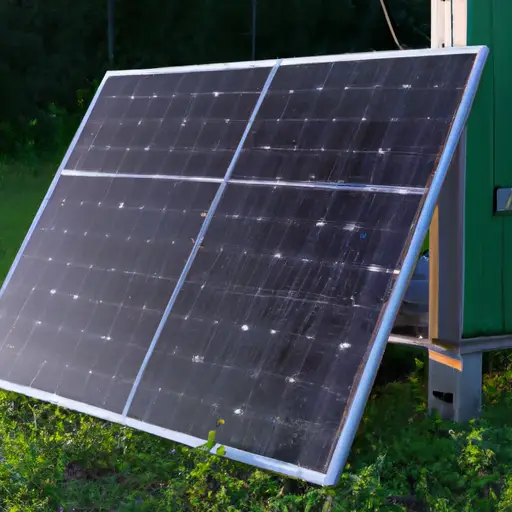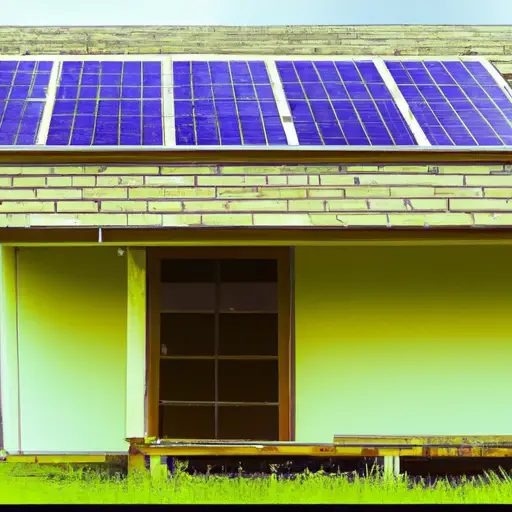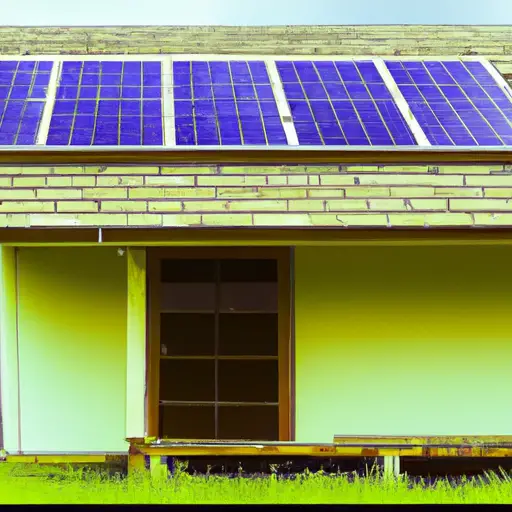Have you ever wondered what it would be like to live off the grid? To disconnect from the hustle and bustle of the modern world and rely solely on your own resources? It’s a lifestyle that can be both challenging and rewarding, and in this ultimate guide to off-grid living, we will delve into everything you need to know about this alternative way of life.
One of the first questions that may come to mind when considering off-grid living is where in the world is the most off the grid? While there are off-grid communities and individuals scattered across the globe, some countries stand out as particularly popular for those seeking a self-sufficient lifestyle. We will explore these countries in detail and discuss the factors that make them attractive for off-grid living.
In this comprehensive guide, we will cover everything from finding the perfect piece of land for your off-grid homestead to generating your own power and ensuring a sustainable water supply. We will also delve into the challenges and benefits of off-grid living, offering insights and advice based on real-life experiences. So, if you’re ready to embark on a journey towards a simpler, more self-reliant life, keep reading to discover the ultimate guide to off-grid living.

The Ultimate Guide to Off-Grid Living
Off-grid living refers to a lifestyle that is completely self-sufficient and independent from public utilities such as electricity, water, and sewage. It involves creating a sustainable and environmentally-friendly home that relies on renewable energy sources, self-sufficient food production, and responsible waste management. While this lifestyle may not be for everyone, it offers numerous benefits for those seeking a simpler and more sustainable way of life. In this ultimate guide, we will explore the key considerations, challenges, and strategies involved in off-grid living.
1. What is Off-Grid Living?
Off-grid living is the choice to disconnect from public utilities and live independently without relying on external sources of energy, water, or food supply. It allows individuals to reduce their carbon footprint, become more self-reliant, and embrace a simpler lifestyle. However, it is important to carefully consider both the benefits and challenges before making the decision to go off-grid.
1.1 Benefits of Off-Grid Living
One of the significant advantages of off-grid living is reducing reliance on fossil fuels and decreasing carbon emissions. By utilizing renewable energy sources such as solar power, wind power, or hydro power, individuals can generate their own electricity without contributing to climate change. Additionally, living off the grid promotes self-sufficiency in terms of food production, reducing reliance on industrial farming and decreasing the carbon footprint associated with transporting goods.
Off-grid living also offers financial benefits. While there are upfront costs associated with setting up an off-grid home, the long-term savings can be substantial. By generating their own energy and water, off-gridders can significantly reduce or eliminate monthly utility bills. Additionally, growing your own food and practicing sustainable waste management can further decrease expenses and promote a more frugal lifestyle.
Beyond the environmental and financial benefits, off-grid living provides individuals with a greater sense of independence and freedom. With complete control over their energy, water, and food supply, off-gridders are not dependent on the stability of public utilities or subjected to potential disruptions such as power outages. It also offers the opportunity to reconnect with nature and live in harmony with the natural surroundings.
1.2 Challenges of Off-Grid Living
While off-grid living has numerous benefits, it also presents unique challenges that need to be addressed. One of the main challenges is finding the right location and land for an off-grid home. Factors such as access to sunlight, wind patterns, and water sources need to be carefully considered when choosing a suitable location. Additionally, legal and zoning regulations may vary, so it is important to research local regulations to ensure compliance.
Another challenge is the initial investment required to set up an off-grid power system. Solar panels, wind turbines, and hydro generators can be costly, and the overall cost will depend on the energy needs of the household. Additionally, the maintenance and upkeep of these systems require technical knowledge and skills. It is important to have a backup power source, such as battery storage or a generator, in case of unexpected energy shortages.
Water supply is another critical consideration. Off-grid homes must secure a reliable water source, which may involve rainwater harvesting, drilling wells, or accessing natural springs. Proper filtration and purification systems are also necessary to ensure the availability of clean and safe drinking water.
Waste management is another challenge of off-grid living. Off-grid homes should incorporate composting toilets, greywater systems, and recycling practices to minimize waste and promote sustainability. These systems require careful maintenance and adherence to proper protocols to prevent environmental harm.
Finally, achieving self-sufficiency in food production can be a time-consuming and labor-intensive task. Growing your own food involves learning gardening techniques, managing crops, and dealing with potential pests or diseases. It also requires ample space and suitable soil conditions. For those who do not have access to adequate land, alternative options such as community gardens or joining agricultural cooperatives can provide opportunities for self-sufficiency.
2. Essential Considerations for Off-Grid Living
To successfully live off the grid, several essential considerations need to be addressed. These considerations include location and land, energy sources, water supply, waste management, and food production.
2.1 Location and Land
Choosing the right location and obtaining suitable land is crucial for off-grid living. The land should have access to sunlight for solar panels or open areas for wind turbines. It should also have an adequate water source, preferably a natural spring or a reliable underground water supply. Additionally, consider the local climate, soil fertility, and legal or zoning restrictions that may impact your off-grid lifestyle.
2.2 Energy Sources
Generating your own energy is a fundamental aspect of off-grid living. Solar power is a popular and reliable choice, especially in sunny regions. Solar panels can be installed on rooftops or dedicated areas to harness the sun’s energy and convert it into electricity. Wind power and hydro power are also viable options, depending on the available resources in the chosen location. Investing in quality equipment and designing an efficient energy system is essential for long-term sustainability.
2.3 Water Supply
Having a consistent and reliable water supply is crucial for off-grid living. Rainwater harvesting is an excellent method to collect and store rainwater for domestic use. Installing a system that directs rainwater from the roof into storage tanks ensures a constant supply of water. Drilling wells or accessing natural springs are also options to consider, depending on the availability of underground water sources in the area. It is important to regularly monitor water levels, maintain water storage tanks, and implement filtration and purification systems to ensure the water’s quality and safety.
2.4 Waste Management
Proper waste management is essential for maintaining a sustainable off-grid home. Composting toilets are a popular choice as they convert human waste into nutrient-rich compost for gardening. Greywater systems collect and treat water from sinks, showers, or washing machines, allowing it to be safely reused for irrigation purposes. Implementing recycling practices and reusing materials whenever possible also play a crucial role in minimizing waste and promoting sustainability.
2.5 Food Production
Growing your own food is not only a sustainable practice but also contributes to self-sufficiency. Creating a vegetable garden or cultivating fruit trees can provide a steady supply of fresh produce. Vertical gardening or raised beds can be utilized in limited spaces. Additionally, raising livestock such as chickens for eggs or goats for milk can further enhance self-sufficiency. Learning about permaculture techniques and practicing crop rotation and natural pest control methods are essential for successful food production.
3. Setting Up Off-Grid Power Systems
One of the primary considerations for off-grid living is setting up a reliable and efficient power system. Here are some common options for off-grid power generation:
3.1 Solar Power
Solar power is the most widely used renewable energy source for off-grid living. Solar panels capture energy from the sun and convert it into electricity. This energy can be stored in batteries for later use or used immediately to power appliances or charge devices. Investing in high-quality solar panels and batteries is essential for maximizing efficiency and sustainability.
3.2 Wind Power
In areas with consistent and strong winds, wind power can be an effective energy source. Wind turbines capture the energy from the wind and convert it into electricity. Like solar power systems, wind power systems require an energy storage solution, such as batteries, to provide electricity during times of low or no wind.
3.3 Hydro Power
If there is a reliable water source with sufficient elevation change, hydro power can be harnessed to generate electricity. Small-scale hydro generators use the natural flow of water to produce power. This method can be highly efficient and reliable, particularly for off-grid homes located near rivers or streams.
3.4 Battery Storage
Battery storage is crucial for off-grid power systems, as it allows for the storage and use of energy during periods of low energy production. Deep-cycle batteries, such as lead-acid or lithium-ion batteries, can store excess energy generated by solar panels, wind turbines, or hydro generators. Proper maintenance and monitoring of battery systems are necessary to ensure their longevity and efficiency.
3.5 Backup Generators
Having a backup generator is an important consideration for off-grid living, especially during extended periods of low energy production. Backup generators, usually powered by propane or diesel, can provide electricity when renewable energy sources are insufficient. It is essential to properly size the generator based on energy needs and to regularly maintain and test it to ensure reliability.
4. Sustainable Water Solutions for Off-Grid Living
Securing a sustainable and reliable water supply is essential for off-grid living. Here are some common methods for water procurement and management:
4.1 Rainwater Harvesting
Rainwater harvesting involves collecting and storing rainwater for domestic use. This method usually relies on capturing rainwater from rooftops and directing it into storage tanks via gutters and pipes. Investing in a filtration and purification system ensures that collected rainwater is safe for drinking and other household needs.
4.2 Wells and Boreholes
Drilling wells or utilizing existing boreholes can provide off-grid homes with access to underground water sources. It is important to consult professionals to determine the feasibility and safety of drilling a well or using a borehole. Regular maintenance and water testing are necessary to ensure the quality and availability of the water.
4.3 Water Filtration and Purification
Regardless of the water source, implementing proper filtration and purification systems is crucial for ensuring the safety and quality of drinking water. Water filters, such as activated carbon filters or reverse osmosis systems, can remove impurities and contaminants. UV sterilization systems can also be used to kill harmful bacteria and viruses. Regular maintenance and replacement of filter components are necessary to ensure the effectiveness of these systems.
5. Waste Management Strategies for Off-Grid Living
Implementing effective waste management strategies is essential for minimizing environmental impact and promoting sustainability in off-grid living. Here are some common waste management practices:
5.1 Composting Toilets
Composting toilets are a sustainable alternative to traditional flush toilets. They convert human waste into compost, which can later be used as fertilizer for non-edible plants. Composting toilets require proper ventilation and maintenance to ensure effective decomposition and odor control.
5.2 Greywater Systems
Greywater systems collect and treat water from sinks, showers, and washing machines for reuse in irrigation or toilet flushing. These systems help conserve water and reduce the overall water footprint of an off-grid home. Proper maintenance and ensuring that greywater does not come into contact with edible crops are essential for health and safety.
5.3 Recycling and Reusing
An important aspect of waste management in off-grid living is recycling and reusing materials whenever possible. Implementing a recycling program for items such as plastics, glass, and paper is crucial. Additionally, adopting a mindset of reusing materials or repurposing items can significantly decrease waste generation.
6. Self-Sufficiency in Off-Grid Living
Self-sufficiency is a key goal of off-grid living. Here are some strategies for achieving self-sufficiency in various aspects:
6.1 Growing Your Own Food
Growing your own food is an integral part of self-sufficiency in off-grid living. Setting up a vegetable garden, orchard, or greenhouse allows you to have a constant supply of fresh produce. Learning about organic gardening techniques, companion planting, and natural pest control methods can help maximize productivity and sustainability.
6.2 Raising Livestock
Raising livestock can further enhance self-sufficiency in off-grid living. Chickens, for example, provide a source of eggs and meat, while goats can provide milk and cheese. It is essential to have adequate space and proper husbandry practices to ensure the health and well-being of the animals.
6.3 Hunting and Foraging
For those living in rural or wilderness areas, hunting and foraging can provide additional food sources. Learning about local edible plants, responsible hunting practices, and regulations is crucial to ensure sustainability and respect for the environment.
7. Building and Designing an Off-Grid Home
Building an off-grid home involves careful consideration of environmentally friendly materials, passive solar design, insulation, and ventilation. Here are some key aspects to consider:
7.1 Environmentally Friendly Materials
Choosing environmentally friendly materials helps reduce the carbon footprint of an off-grid home. Opt for materials such as sustainably harvested wood, recycled materials, or natural materials like adobe or straw bales. Consider local sourcing to reduce transportation emissions.
7.2 Passive Solar Design
Passive solar design takes advantage of the sun’s heat and light to naturally warm and illuminate the home. This design approach includes properly orienting the building, using high-quality windows and insulation, and utilizing thermal mass to store and distribute heat.
7.3 Insulation and Ventilation
Proper insulation is crucial for maintaining a comfortable temperature in an off-grid home. Insulate walls, floors, and roofs to reduce energy loss. Additionally, implement passive ventilation strategies such as natural airflow and strategic window placement to ensure adequate air circulation and reduce the need for mechanical cooling or heating.
8. Mental and Emotional Preparedness for Off-Grid Living
Adjusting to off-grid living requires mental and emotional preparedness. Here are some important considerations:
8.1 Adjusting to Solitude
Off-grid living often involves a higher degree of solitude, especially for those living in remote areas. Embracing solitude and finding a sense of peace and contentment in nature are important aspects of mental preparedness.
8.2 Developing Skills and Hobbies
Living off the grid provides ample opportunities to learn new skills and develop hobbies. Embrace activities such as gardening, woodworking, or crafting, which not only contribute to self-sufficiency but also promote mental stimulation and fulfillment.
8.3 Stress Management
Off-grid living may present unique challenges and potential sources of stress. Developing effective stress management techniques, such as mindfulness, meditation, or engaging in physical activities, can help maintain overall well-being and improve mental resilience.
9. Off-Grid Communities and Networking
For those considering off-grid living, connecting with like-minded individuals and sharing resources and knowledge is invaluable. Here are some ways to find and engage with off-grid communities:
9.1 Finding Like-Minded Individuals
Joining online forums, attending sustainable living conferences, or participating in local skill-sharing events can help connect with individuals who share similar interests and lifestyles. Engaging in discussions, seeking advice, and sharing experiences can foster a supportive community.
9.2 Sharing Resources and Knowledge
Off-grid living is a continuous learning process. Sharing resources, knowledge, and experiences with others in the off-grid community can be mutually beneficial. Participating in skill-sharing workshops or contributing to online platforms can help expand your knowledge and contribute to a vibrant community.
10. Conclusion
Off-grid living offers individuals the opportunity to live sustainably, reduce their ecological footprint, and embrace a simpler way of life. By carefully considering the key aspects of off-grid living and implementing strategies for sustainable energy, water supply, waste management, and food production, it is possible to create a self-sufficient and environmentally-friendly off-grid home. Remember to connect with like-minded individuals, continuously learn and adapt, and cherish the unique benefits that off-grid living has to offer.





